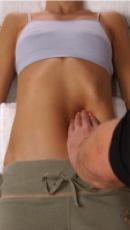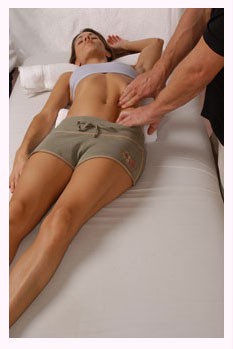Deep Tissue Massage Therapy
Deep Tissue Massage Therapy tends to be more focused on specific tissues addressing a specific complaint of the Client.
The Typical Deep Tissue Massage Approach

There is often an assumption on the part of a typical Deep Tissue Massage Therapist that their “job” is to “dig in” really deep to “find” and “work out” the problems, such as “knots” in the muscle fibers.
For Example, some deep tissue therapists treat the muscle very locally and in isolation, as if they were just “breaking up” the tensions, adhesion, scar tissues, calcifications, or other aspects of pain, dysfunction, or pathology causing elements within the muscle itself. This approach is very often effective, even though the “science” behind wha they are doing is questionable to say the least..
However, many Clients are too traumatized, stressed, injured or “tissue damaged” to endure really deep work. Or the Client is too DE-sensitized, and is actually being hurt and not knowing it. Some Clients just cannot tolerate the pain, and then they look for a modality or practitioner that hurts less than the pain they already have!
Some Oriental Muscle Modalities use deep manual pressure to “stimulate or reduce the flow” of “chi energy” through the “meridians.” This approach relies on the Oriental Medicine Philosophy that acupuncture & herbology come from, and might require the Client to have more of a “leap of faith” than some are willing to allow. The question is, how well does that model of the human body and pathology fit the problems the client presents with?
The NCSAB Approach To
“Deep Tissue Massage”
At NCSAB, our overarching philosophy is, in great part, that excess nerve activity in the central nervous system (CNS) and brain send motor signals to a muscle, causing the muscle fibers to excessively contract, and very often stay (chronically) contracted. As long as that nerve charge is activated, the muscle (or organ) will stay activated & contracted, and CANNOT relax.
Our medical massage & bodywork technique employs manual (hands-on) pressure on the muscle not to “treat the muscle” per se. We use manual pressure on the skin & muscle to stimulate certain nerve signals into the CNS & Brain. (CNS = central nervous system.)
This stimulation, if done properly, causes the nerve pathways & synapses (synapses = “switches controlling nerve flow”) to “reset” the amount of nerve charge they are sending to the muscle(s), (or organs). That usually results in the REDUCTION of nerve charge to the muscle or organ. That reduction of nerve charge to the muscle IS the “relaxation,” the “DE-contracting” of the muscle, and DE-stressing of the neuro-musculo-fascial system.
Does Deep Tissue Massage Therapy
Need to HURT To Be Effective?

As the Client’s muscle(s) relax(es), the therapists’ fingers or hands, or even elbow, will sink deeper into the muscle belly. As the therapist sinks deeper, new layers of tension are often encountered, bringing up new levels of sensation (sometimes uncomfortable or even painful) to the Client’s perception. It is the Client’s job to give feedback to the Therapist, letting them know they are going too deep, or too fast, or both.
The Therapist then backs off slightly, or a lot, until the Client’s neuro-muscular tissue relaxes and the Client is comfortable again. Then, the Therapist can proceed to sink even deeper into the muscle belly. Clients often report that with this approach, the Therapist can get much deeper into the tissue than “standard” deep tissue therapists do, and we can stay in the tissues longer, finding and releasing more of the chronically contracted muscle tissues.
In this way, Deep Tissue Massage, done according to NCSAB Principles Of Therapy (No Pain, MORE Gain) does not have to hurt to be effective.
In fact, in many cases, it is counter-productive, or make the Client worse.
The amount of pressure can be similar to classic Swedish Massage but focusing primarily on relieving tension in the deeper layers of muscles and fascia tissue. In Swedish-style Therapy, the applied pressure will be deeper and the strokes much slower. Special attention may be given to problem areas of chronic tension.
So, even Swedish style massage can be “deep tissue” if the Client and Therapist are patient enough to allow the tissues to Relax & Let-Go.

